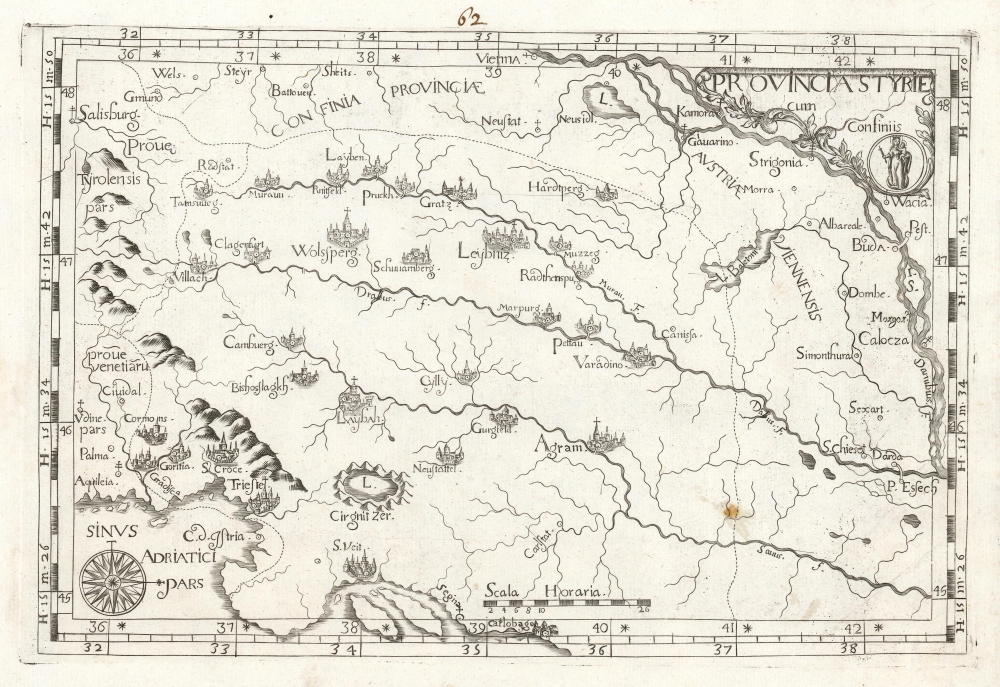1714 Montecalerio Map of Croatia, Slovenia and Austria and its Capuchin Monasteries
Stiria-montecalerio-1714
Title
1714 (undated) 8.5 x 12.75 in (21.59 x 32.385 cm) 1 : 1900000
Description
A Closer Look
It spans from Vienna in the north to the Adriatic Sea and the Danube River borders the north and east. The map's western limits reach the borders of the Venetian Republic and the Austrian Tyrol. It thus includes not only the modern Austrian state of Styria, but also large parts of the modern countries of Slovenia and Croatia. In addition to Vienna, the cities of Buda, Pest, Trieste, Gorizia, Ljubljana (Laybach), Zagreb (Agram), Varadzin (Varadino), Leibnitz, and Graz can all be found, strung along the Mura, Drava, and Sava rivers.The Balkan Capuchins
Giovanni da Moncalieri (Latin, Johannes a Montecalerio) was a highly-placed Franciscan monk, who traveled widely in Europe engaged in the surprisingly convoluted politics of the Capuchin order. In 1643 he published an atlas of Europe, marking the cities containing Capuchin monasteries. This map - from the re-engraved 1712 edition of the atlas - does so for Slovenia, Croatia, and part of Austria by marking the relevant cities with crosses. Trieste, Zagreb, Laibach, and Liebnitz all had monasteries, for example, while Varaždin and Buda/ Pest did not.Beautiful Detail
The map is simply engraved, but neatly and attractively. It is embellished with a compass rose in the lower left. A triangular floral cartouche nestled in the upper right beyond the Danube contains a medallion bearing a Madonna and Child.Publication History and Census
This map was composed by (or for) Giovanni da Moncalieri in 1643. The maps for this 1714 edition were re-engraved by the Milanese illustrator Simone Durello. The atlas, in its various editions, appears to be cataloged 32 times in institutional collections. The separate map is so listed only three times in OCLC.CartographerS
Giovanni da Moncalieri (Latin: Joannis à Montecalerio) (1579 - 1655) was an Italian. He was born in Moncalieri of the noble Moriondo family, and became a member of the court of Savoy. He studied law, but upon graduation became a Franciscan friar of the Capuchin order. As a monk he became a reader of philosophy, and a master of theology; he traveled and preached in the Piedmont region, but was sent on missions as far as Geneva. His facility in political matters, and his command of languages led him to be chosen as an aide to the Father General of the order. Between 1628 and 1631 he traveled, in a diplomatic role, throughout Spain, France, Flanders, Germany, Switzerland, Austria, and the Italian provinces. Following the death of the Father General on 4 February 1631, he returned to Moncalieri, which had suffered plague, famine and war. In 1633, internal Order politics called him to Rome, where he was appointed Definitor General, the third highest office in the order. His duties kept him in Rome until 1643, at which point he returned to the Piedmont. Beginning in 1641 he began to publish epistles; in 1643 he produced the first edition of his Chorographica Descriptio Provinciarum, an atlas of the convents of the Capuchin order. This work would be republished in four later editions. He died in Moncalieri in 1655. More by this mapmaker...
Simone Durello (1641-1719) was an Italian engraver. He is only known through his works, which included maps and illustrations in an array of works published primarily in Milan. Learn More...

